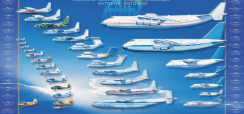The Flight Test and Development Base (FT&DB) of ANTONOV Company is a complex for ground and flight tests, research of airplanes, their power plants and systems, airborne equipment of civil and special purposes, as well as for cargo and personnel airdrop training.
Aerodrome Complex and Flight Test Zone
1) Kyiv ANTONOV-2 Airfield where FT&DB is located, is the ANTONOV Company’s base airfield intended to perform ground and flight tests, flight and maintenance personnel training, air cargo transportation, scheduled maintenance operations, and aircraft maintenance. The airfield is included in air navigation data charts of Ukraine and international charts such as JEPPESEN.
2) Kyiv ANTONOV-2 Airfield has a paved runway of 3,500 meters long and 56 meters wide, taxiway and tracks for aircraft weighting up to 650 tons allowing take-off and landing of all known aircraft including the heaviest AN-225 Mriya.
3) Radar and radio communications equipment, lighting equipment with scrolling text display, meteorological equipment of airfield are provided to ensure the fulfilment of aircraft test and scheduled flights any time of day or night under standard and adverse weather conditions according to the ICAO Categories (I and II).
4) Test Flight Zone of 300 km allows performing most of aircraft tests.
5) Aircraft parking stands including those with deflecting baffles are equipped with electrical power sources and lights. Possibility to perform a whole range of ground tests including engine ground tests in all required modes is provided at the parking places.
6) There is a unique beam balance weight complex enabling weighing all types of aircraft including AN-225 Mriya.
7) The existing ground satellite correction station with geodetic connection to the place of installation in combination with the airborne trajectory measuring complex allow to implement a differential calculation mode that provides measurements of the moving aircraft trajectory with accuracy up to 5 meters, and when applying a phase equalization – up to 70 centimeters.
Test Stands and Laboratories
To provide aircraft testing and researching, the Flight Test and Development Base is properly fitted with stands and laboratories as follows:
- Calibrating stands for force tensometry calibration of experimental aircraft’s airframe and landing gear;
- Calibrating stands for fuel management and indicating system of aircraft fuel tanks;
- Emitting Radar stand;
- Radio communications equipment stand; flight and navigation equipment stand;
- Stand for installation, maintenance, and calibration of airborne measurement systems;
- Strength measurement stand;
- Stand for installation and maintenance of airborne video systems and video/photographic equipment.
Airborne Measurement Systems installed on Experimental Aircraft
1) The ANTONOV Company’s experimental aircraft are equipped with airborne measurement systems in accordance with the tests program. Aircraft development is followed with growing list of parameters measured during a flight tests, the extending frequency range of changes of these parameters, the increasing volume of measured data received after each flight for processing. Currently, while testing the prototypes such as AN-178 and AN-132, their airborne measurement systems allow collecting and recording up to 30,000 parameters; the maximum frequency of measurements reaches 20 kHz, and the amount of data accumulated during the flight is between 5 and 20 GB.
2) Experimental aircraft are equipped with working stations for principal testing engineers taking part in ground and flight tests. The real-time flight data visual systems (included into on-board checkout and monitoring system) are installed at the principal testing engineers’ stations, which enables to increase the information content of a flight experiment and to reduce the value and terms of tests by the effect of:
- real-time control of experiment – to change modes from simple to more complicated ones during the same flight without landing for the analysis of performed modes;
- integration of different tasks in a flight;
- prompt change of the test task in case of the unsatisfied results of evaluating systems and equipment, which disrupt the initial test task.
Computerized Processing Ground Complex
To accomplish flight data processing, the Computerized Processing Ground Complex (CPGC) was built at the Flight Testing and Development Base for the analysis, backup, storage of information received during the flights. The Computerized Processing Ground Complex (CPGC) includes both modern server hardware, a data processing network, stations for testing engineers and the most up-to-date bundled software for processing and analyzing flight information. Documentation facilities are provided for both graphical and tabular presentation of tests results to enter them into reporting documents as well.




